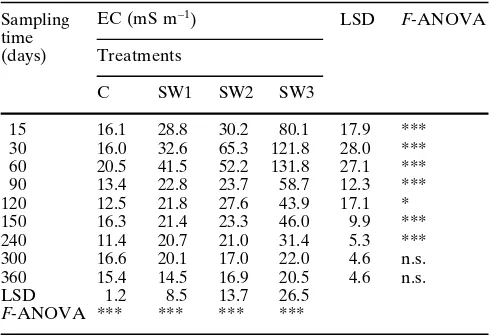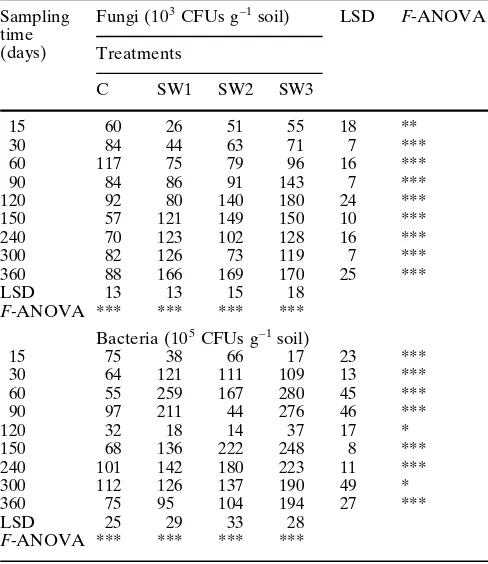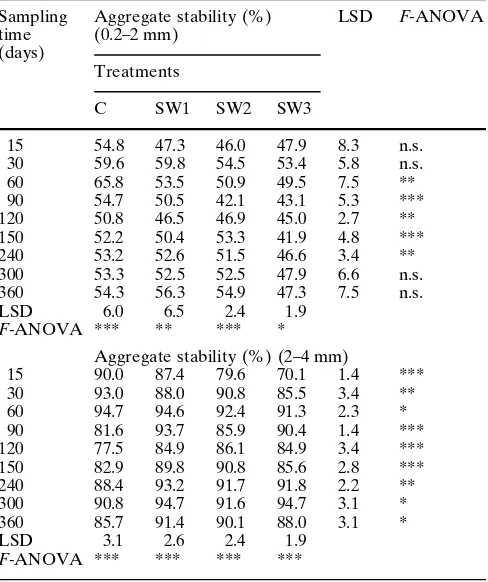ORIGINAL PAPER
C. Guerrero 7 I. Gómez 7 J. Mataix Solera 7 R. Moral
J. Mataix Beneyto 7 M.T. Hernández
Effect of solid waste compost on microbiological and physical
properties of a burnt forest soil in field experiments
Received: 24 November 1999
M.T. Hernández (Y)
Department of Soil and Water Conservation and Organic Waste Management,
Centro de Edafología y Biología Aplicada del Segura, CEBAS-CSIC, P.O. Box 4195, 30080 Murcia, Spain e-mail: mthernan6natura.cebas.csic.es
Tel.: c34-968-215717
Fax: c34-968-266613
C. Guerrero 7 J. Mataix Solera 7 R. Moral 7 J. Mataix Beneyto Department of Agrochemistry and Environment,
Miguel Hernández University, 03202 Elche, Spain I. Gómez
Department of Agrochemistry and Biochemistry,
University of Alicante. P.O. Box 99, 03080 Alicante, Spain Abstract The restoration of soil microbial activities is a basic step in the reclamation of burnt soils. For this reason, the ability of municipal solid waste compost to accelerate the re-establishment of bacterial and fungal populations, as well as to re-establish physical proper-ties in a burnt soil, was evaluated in a field experiment. Four treatments were performed by adding different doses of compost (0, 0.5, 1 and 2 kg compost m–2 soil)
to a burnt Calcic Rodoxeralf soil, and the changes in microbial populations, salt content, aggregate stability and bulk density were evaluated for 1 year. Initially, the addition of compost had a negative effect on soil microbial populations, but 3 months after compost ad-dition, the number of viable fungal propagules in-creased in all the amended soils. This positive effect lasted until the end of the experiment. From 30 days onwards, all the amended soils showed a greater total number of bacterial cell forming units than the una-mended burnt soil. Organic amendment increased the percentage of 2- to 4-mm aggregates, although the ef-fect on the stability of the 0.2- to 2-mm aggregates and on bulk density was less noticeable.
Keywords Aggregate stability 7 Bacteria 7 Burnt soil 7 Compost 7 Fungi
Introduction
Wildfires strongly modify ecosystem characteristics, particularly soil properties, which contribute to the eco-system’s destruction. Soil microbiota, which is the main agent responsible for organic matter decomposition and is involved in the macronutrient cycles (Harris and Birch 1989) is negatively affected by fire (Hernández et al. 1997). The importance of bacteria and fungi in natu-ral soil ecosystems has been well recognised, and mi-crobial activities play an important role in the reclama-tion of disturbed ecosystems, where they contribute to nutrient turn-over, N and P immobilisation (microbial biomass) and the formation of relatively stable aggre-gates (Dinel et al. 1992). In general, bacterial popula-tions often dominate fungi and other microbial groups after fire (Vázquez et al. 1993). The bacterial popula-tion usually returns to normal values very quickly after burning, while fungi seem to recover more slowly. The pre-burnt state may not be reached even after 1 year (Raison 1979). This may be due to an increase in soil pH, changes in or lack of organic matter, and/or the in-hibitory effect of different pyromorphic compounds (Widden and Parkinson 1975).
In order to recover forest ecosystems after wildfires, the physical, chemical and microbiological characteris-tics of the soil have to be re-established. The addition to the soil of an organic material, with a high macro-and micronutrient content macro-and a diverse microbial pop-ulation, will favour the re-establishment of microbial biomass and activity and, hence, plant recovery, reduc-ing the time needed to reach suitable levels of soil pro-tection (Villar et al. 1998)
phy-Table 1 Changes with time in the electrical conductivity (EC) of sical and physico-chemical properties of the soil, were
studied during 1 year.
Materials and methods
The experiment was carried out in a forest soil burnt 5 months previously, located in Bocairente (Valencia, Spain), at 38744b9nN and 0742b9nW. The soil is a Calcic Rhodoxeralf (Soil Survey Staff 1990), and the site (730 m above sea level) has a ~2% slope and
SE orientation. No live vegetation was observed, and the soil had a Munsell colour of 7.5 YR 4/4 (dry) and 10 YR 3/2 (wet) due to the ash cover. During the experimental period, the average tem-perature was 15.37C, the average daily minimum temperature be-ing 8.97C and the average daily maximum temperature 21.77C; the mean annual rainfall was 440 mm. The study was performed in 10-m2 plots randomly located in a burnt area of 3000 m2. Four treatments were established by adding different doses of a muni-cipal solid waste compost from an industrial composting plant in Valdemingómez, Madrid, Spain, to the burnt soil. The application rates of 0, 0.5, 1, and 2 kg compost m–2 soil,(dry basis) shall be referred to as control, SW1, SW2 and SW3 treatments, respective-ly. All the treatments were carried out in quadruplicate. Compost was applied superficially to the burnt soil, and no attempt was made to mix it with topsoil. Samples were taken 15, 30, 60, 90, 120, 150, 240, 300, and 360 days after compost application. Each sample consisted of a mixture of eight randomly collected soil subsamples, taken from the top 15 cm.
Soil chemical and physical analysis
Electrical conductivity (EC) was measured in a 1 : 5 (w/v) aqueous solution at 207C. Chlorides were determined in the above extract by HPLC. Sodium was extracted by 1 N ammonium acetate in a 1 : 10 soil : solution ratio (Knudsen et al. 1982), and determined by emission spectrophotometry. Parameters were analysed in 2-mm-sieved soil samples. Aggregate stability was determined in 0.2- to 2-mm and 2- to 4-mm-diameter soil aliquots, following the meth-od of Benito et al. (1986) mmeth-odified by Roldán et al. (1996). Bulk density was determined in soil clods of 2–3 cm diameter by the method of Barahona and Santos (1981).
Soil microbiological analysis.
Twenty grams of fresh soil were diluted in tenfold series in sterile water. Viable bacterial numbers were determined by plate colony counts (Schmidt 1973) after 5 days of incubation at 287C on Petri dishes containing solid media. The composition of this agar me-dium in 1 l was: 1.15 g bacteriological peptone; 0.15 g some-dium ci-trate; 0.025 g sodium nici-trate; 0.015 g iron (II) sulphate 7-hydrate; 0.015 g magnesium sulphate 7-hydrate; 0.015 g potassium chlo-ride; 0.015 g calcium chlochlo-ride; agar technical n73,11 (Oxoid). Via-ble fungus propagules (CFU) were determined in rose bengal agar (Oxoid) (Martin 1950) with the same dilution plate method (Schmidt 1973).
Data were analysed using one-way ANOVA and significant differences between means were determined by Tukey’s test.
Results and discussion
The addition of compost increased soil EC in a dose-dependent manner (Table 1). These values increased during the first 60 days following the addition of com-post, an increase attributable to the solubilisation of soluble ions like chlorides, sulphates and sodium from
the compost and inorganic species formed by organic matter mineralisation. After heavy rainfall, the EC de-creased in all the treatments due to salt leaching, as confirmed by the increase in EC observed in the 15- to 30-cm-deep soil samples after rain (data not shown). High correlation coefficients were obtained between EC and the chloride (r10.96; P~0.001) and sodium (r10.0.84; P~0.001) content, particularly in amended soils. No statistically significant differences were de-tected between treated and untreated soils after 300 days. amounts of salts and other substances toxic to the soil’s native fungi. García and Hernández (1996) indicated that sodium sulphates and chlorides have a negative ef-fect on soil microbial activity and microbial biomass, this negative effect being much more noticeable in the case of sodium chloride. However, it was observed that during the first 60 days, the number of fungal propa-gules in the treated soils increased with increasing amounts of added compost: SW31SW21SW1, a fact explained by the high level of fungi in the compost (6800 103 CFUs g–1). These compost fungi are adapted
suffi-Table 2 Changes with time in the micro-organism populations (cell forming units; CFUs) of the amended and unamended soils. For other abbreviations, see Table 1
Sampling phates from the topsoil. As a direct consequence of the diminished levels of these toxic substances, the number of fungal CFUs in the SW1 and SW2 treatments at 90 days reached the levels found in the untreated soil, while the numbers in the SW3 treatment exceeded those of the unamended soil. A great increase in fungal CFUs was again detected in treated soils 120 days after soil amendment, particularly in the intermediate (SW2) and high (SW3) dose treatments. This fact can be ex-plained by:
1. The leaching of salts caused by two consecutive in-tense rainfall events (140 mm in 48 h) which took place some time before sampling.
2. The decomposition of toxic substances, other than salts, in the medium.
3. The positive effects of compost addition on soil characteristics (increased organic matter, nutrients, etc.), which would have stimulated fungal growth. The fungal CFUs detected at this stage would now have been both native (from the soil) and exogenous (from the compost).
The bacterial populations evolved differently from the fungi. At the first sampling date (15 days), the num-ber of viable bacterial CFUs in the amended soils was in general lower than that observed in the unamended soil (Table 2), probably due to the presence in the
com-post of substances which inhibited or were toxic to via-ble micro-organisms, or due to the anaerobic condi-tions caused by the mineralisation of the added organic matter. This negative effect had disappeared by the matter added with the compost counterbalancing the negative effect of the toxic substances.
2. The ability of the soil bacterial population to adapt to the new soil conditions and their developing re-sistance to the toxic substances.
3. The natural degradation or leaching of the toxic sub-stances.
The number of bacteria in the unamended soil fol-lowed seasonal changes, although the variations in this soil were wider than in the amended soils, which were enriched with bacteria added with the compost. This may have been due to the reduction in microbial com-munity diversity caused by fire (Staddon et al. 1998), which was not completely restored in the unamended soil.
Aggregate stability (0.2–2 mm)
Table 3 Changes with time in the percentage of stable aggregates and unamended soils. For abbreviations, see Table 1
Sampling the addition of compost was seen to have a slightly ne-gative effect on aggregation (Table 3). After this peri-od, aggregation was significantly higher in the amended soils at all doses. This increase in the percentage of sta-ble aggregates in the amended soils can be attributed both to salt leaching and to the increase in microbial populations. Positive correlation coefficients between the percentage of 2- to 4-mm stable aggregates in the amended soils and the number of CFUs of viable bacte-ria were observed (rp0.8049, P~0.01; rp0.6862,
P~0.05; and rp0.7306, P~0.05, for SW1, SW2 and SW3, respectively).
Bulk density
Bulk density did not show any clear tendency. Initially, bulk density values were slightly higher in the amended soils, which could be explained by the changes ob-served in the 0.2- to 2-mm aggregate stability, there be-ing a close relationship between aggregation and bulk density (Clapp et al. 1986). The values of bulk density in all the soils (amended and control) tended to
stabil-ise at F1.3–1.4 g cm–3. Such a value is probably optimal for this soil, and the application of compost would only accelerate the natural evolution of bulk density. This hypothesis is supported by the fact that bulk density did not change with time in the SW3 treatment, whereas significant changes were observed in the control (Ta-ble 4).
In conclusion, from the above results it can be con-cluded that the addition of MSW compost to burnt soils is a suitable technique for accelerating the natural re-covery process of burnt soils, thus shortening the peri-od of time a soil is exposed to potential erosion proc-esses. Although the addition of compost may initially have a negative effect on soil microbial populations due to the presence in the compost of large amounts of salts and other toxic substances, this effect soon disappears since the toxic substances are degraded and the salts are leached. Therefore, the addition of compost contri-butes to the quicker re-establishment of microbial pop-ulations, which play an important role in aggregate sta-bility and in the biogeochemical cycles of macronu-trients, thus favouring the recovery of plant cover and, consequently, increasing soil protection. Among all the compost rates assayed, 1 kg m–2 (SW2) seemed to be
the most suitable for the reclamation of burnt soils in our experimental conditions, since it stimulated soil fungal and bacterial development and improved the stability of the 2- to 4-mm aggregates. At this dosage the initial negative effects due to the addition of salts or toxic substances with the compost was less noticeable than at the high dose (SW3).
References
Benito E, Gómez-Ulla A, Díaz-Fierros F (1986) Descripción de un simulador de lluvia para estudios de erodibilidad y estabi-lidad de los agregados al agua. An Edafol Agrobiol 45 : 1115–1126
Clapp CE, Stark SA, Clay DE, Larson WE (1986) Sewage sludge organic matter and soil properties. In: Chen Y, Avnimelech Y (eds) The role of organic matter in modern agriculture. Nij-hoff, Dordrecht, pp 209–253
Dinel H, Levesque M, Jambu P, Righi D (1992) Microbial and longchain aliphatics in the formation of stable aggregates. Soil Sci Soc Am J 56 : 1250–1255
García C, Hernández T (1996) Influence of salinity on the biolog-ical and biochembiolog-ical activity of a calciorthird soil. Plant Soil 178 : 255–263
Harris JA, Birch P (1989) Soil microbial activity in opencast coal mine restoration. Soil Use Manage 5 : 155–160
Hernández T, García C, Reinhardt I (1997) Short-term effect of wildfire on the chemical, biochemical and microbiological properties of Mediterranean pine forest soils. Biol Fertil Soils 25 : 109–116
Knudsen D, Peterson GA, Pratt PF (1982) Lithium, sodium and potassium. In: ASA-SSSA (eds) Methods of soil analysis, vol. 2. ASA-SSSA, Madison, Wis., pp 225–246
Lax A, García-Orenes F (1993) Carbohydrates of municipal solid wastes as aggregation factor of soils. Soil Technol 6 : 157–162 Martin JP (1950) Use of acid rose bengal and streptomycin in the
plate method for estimating soil fungi. Soil Sci 69 : 215–232
Raison JR (1979) Modification of the soil environment by vegeta-tion fires, with particular reference to nitrogen transforma-tions: a review. Plant Soil 51 : 73–108
Roldán A, Albadalejo J, Thornes JB (1996) Aggregate stability changes in a semiarid soil after treatment with different or-ganic amendments. Arid Soil Res Rehabil 10 : 139–148 Schmidt EL (1973) The traditional plate count technique among
modern methods: chairmanbs summary. In: Rosswall T (ed) modern methods in the study of microbial ecology. Bull Ecol Res Comm (Stockh) 17 : 437–454
Soil Survey Staff (1990) Keys to soil taxonomy. SMSS technical monograph no. 19. Virginia Polytechnic Institute and State University, Va.
Staddon WJ, Duchesne LC, Trevors JT (1998) Impact of clear-cutting and prescribed burning on microbial diversity and community structure in a Jack pine (Pinus banksiana Lamb.) clear-cut using Biolog Gram-negative microplates. World J Microb Biol 14 : 119–123
Vázquez FJ, Acea MJ, Carballas T (1993) Soil microbial popula-tions after wildfire. FEMS Microbiol Ecol 13 : 93–104 Villar MC, González-Prieto SJ, Carballas T (1998) Evaluation of
three organic wastes for reclaiming burnt soils: improvement in the recovery of vegetation cover and soil fertility in pot ex-periments. Biol Fertil Soils 26 : 122–129


